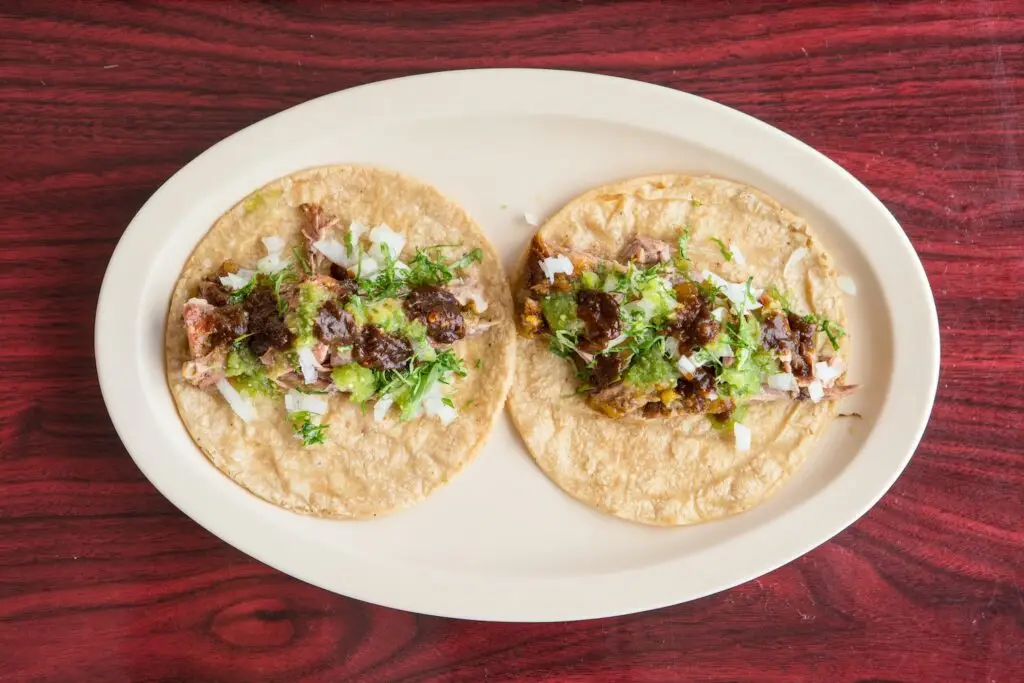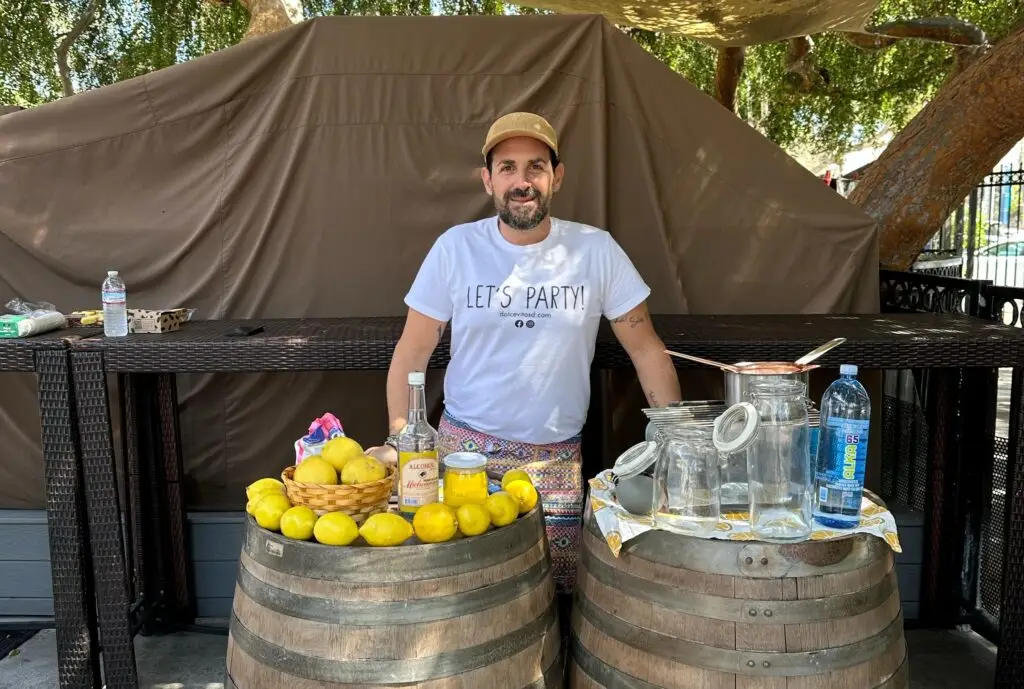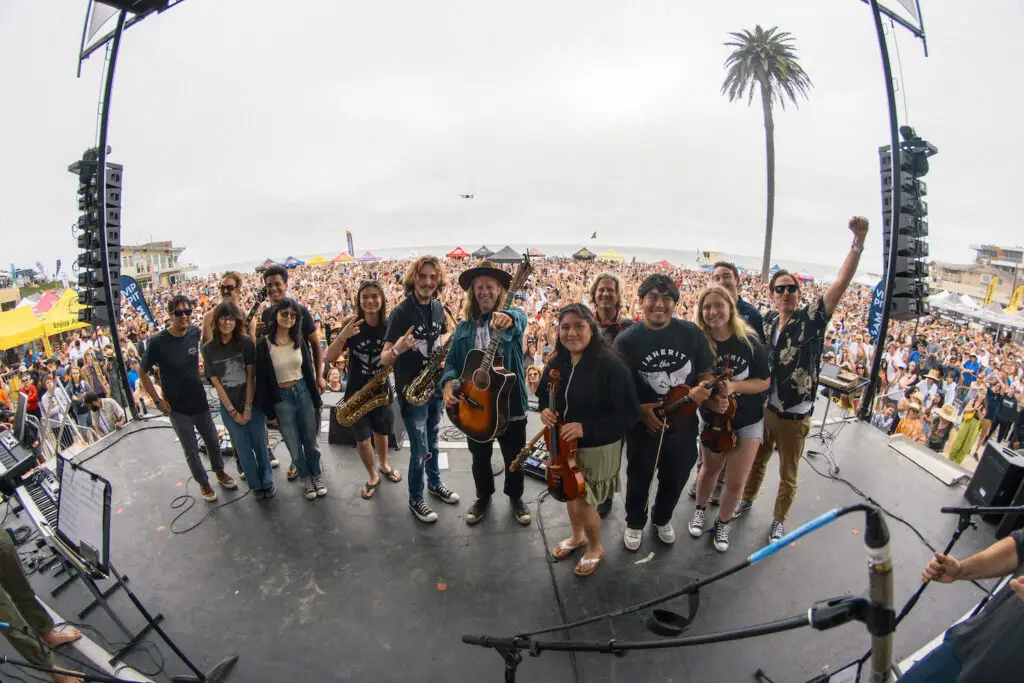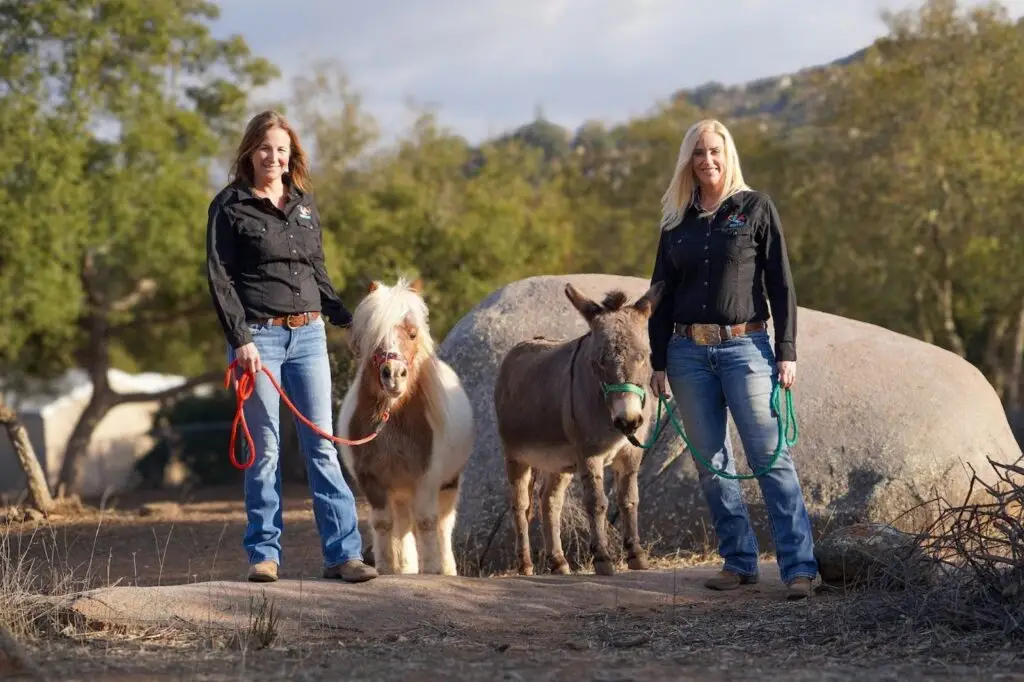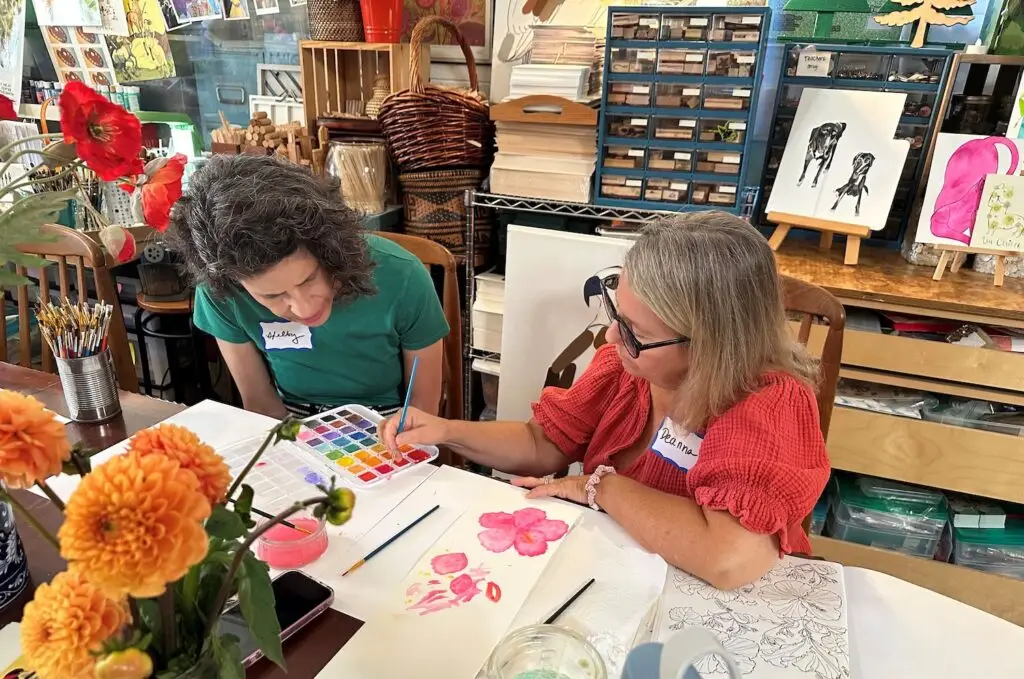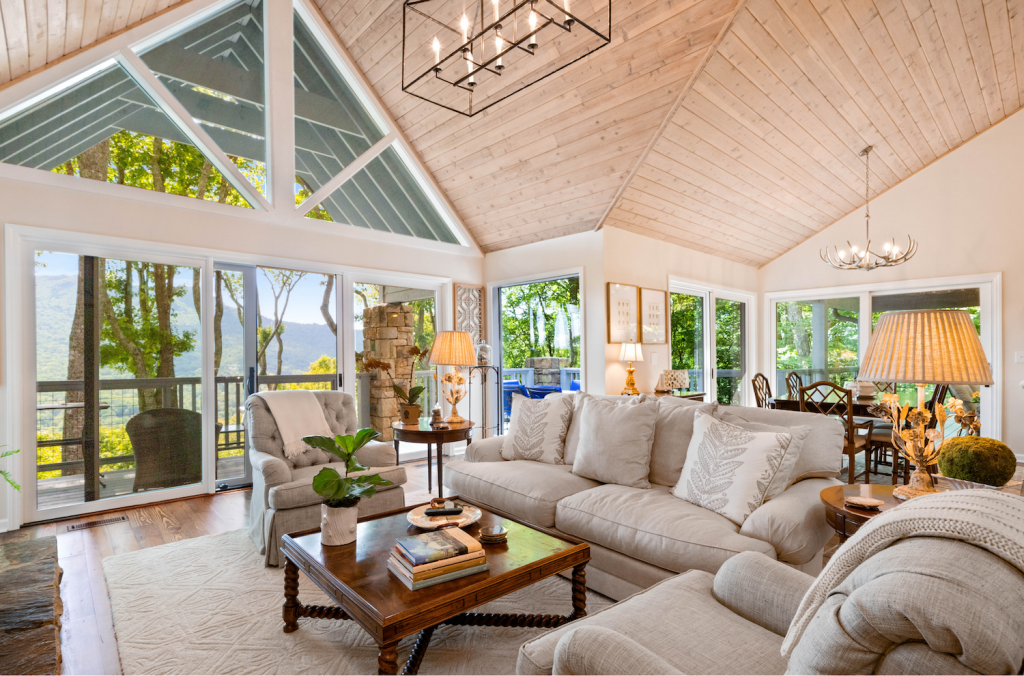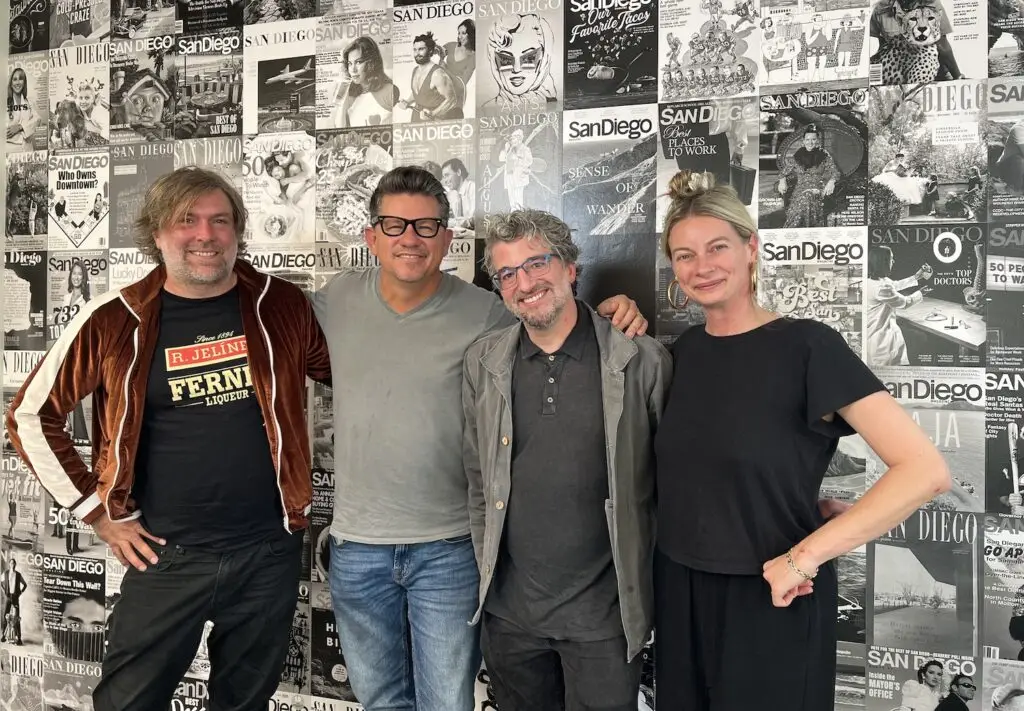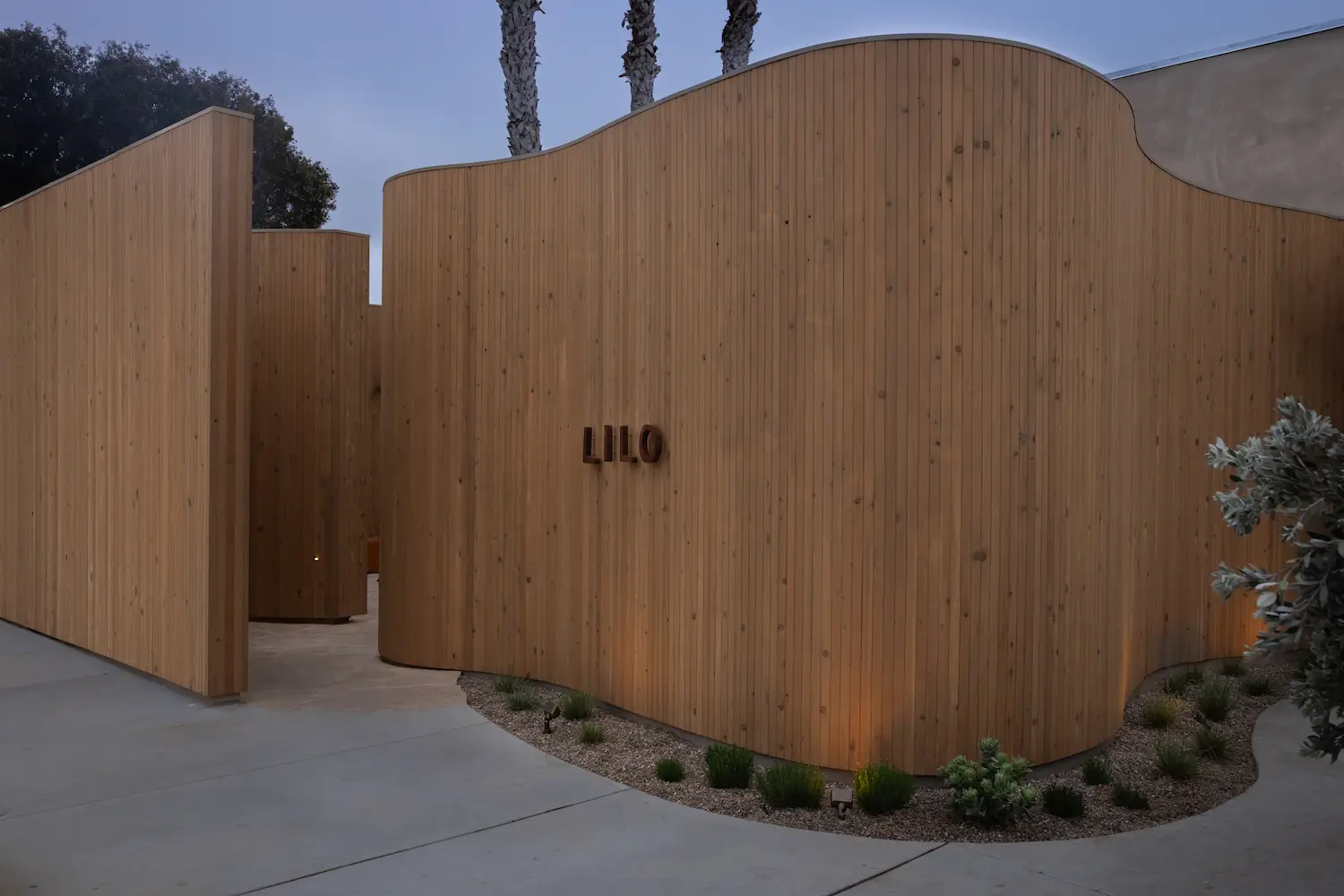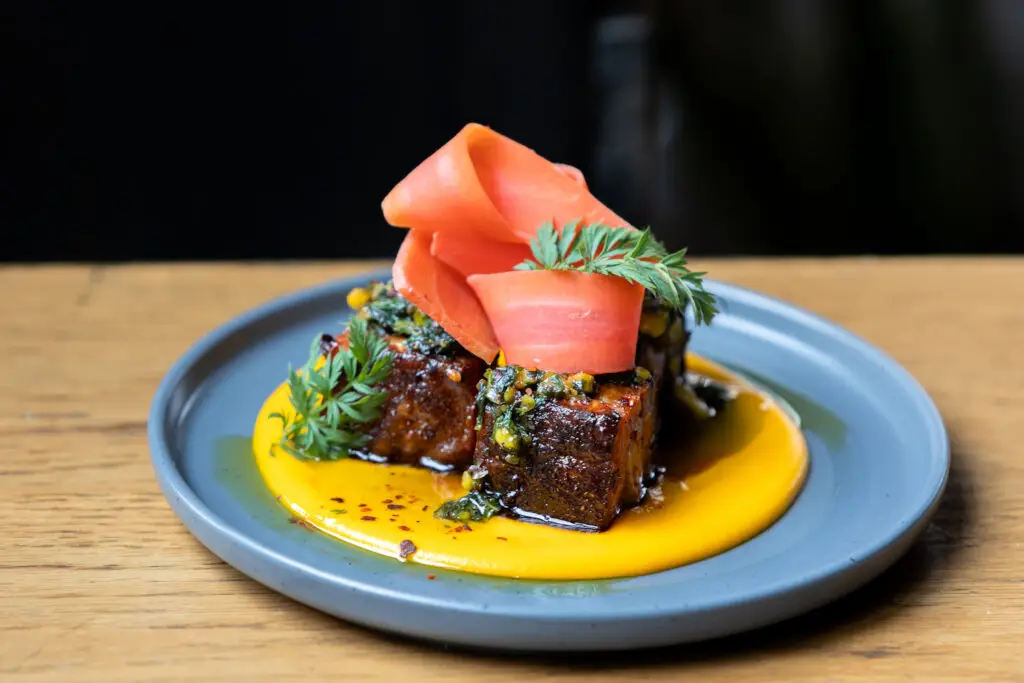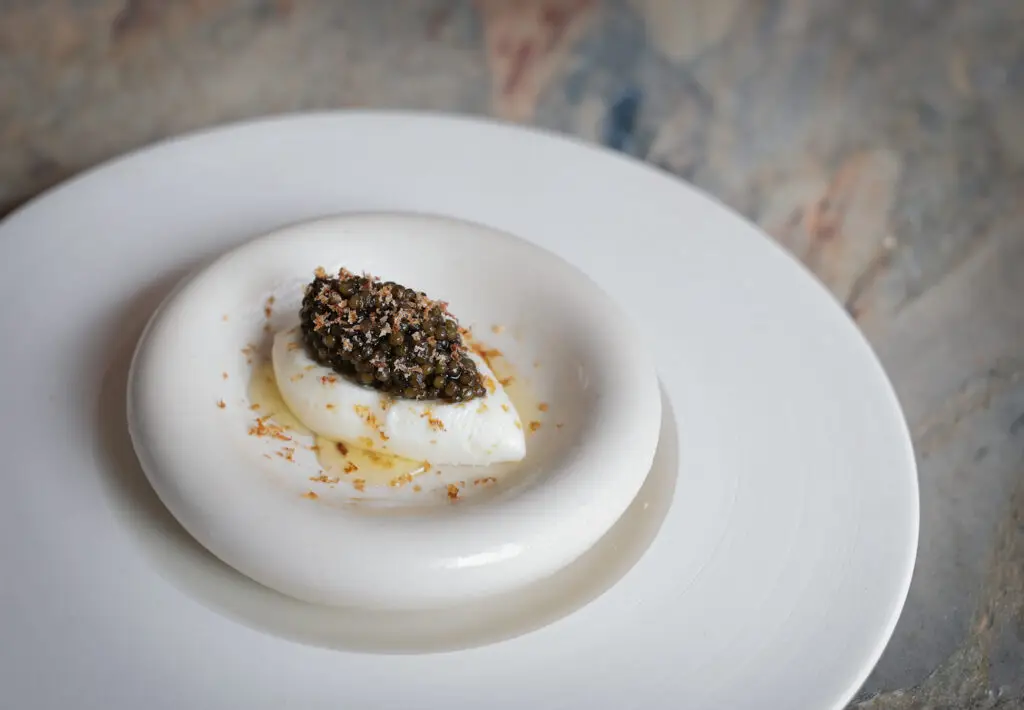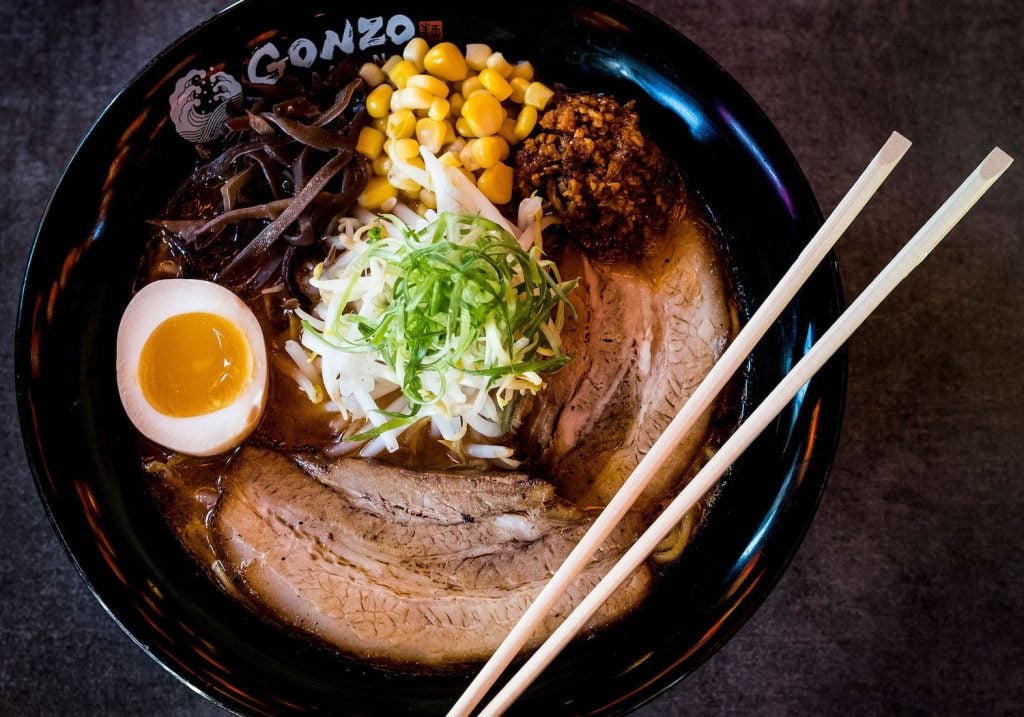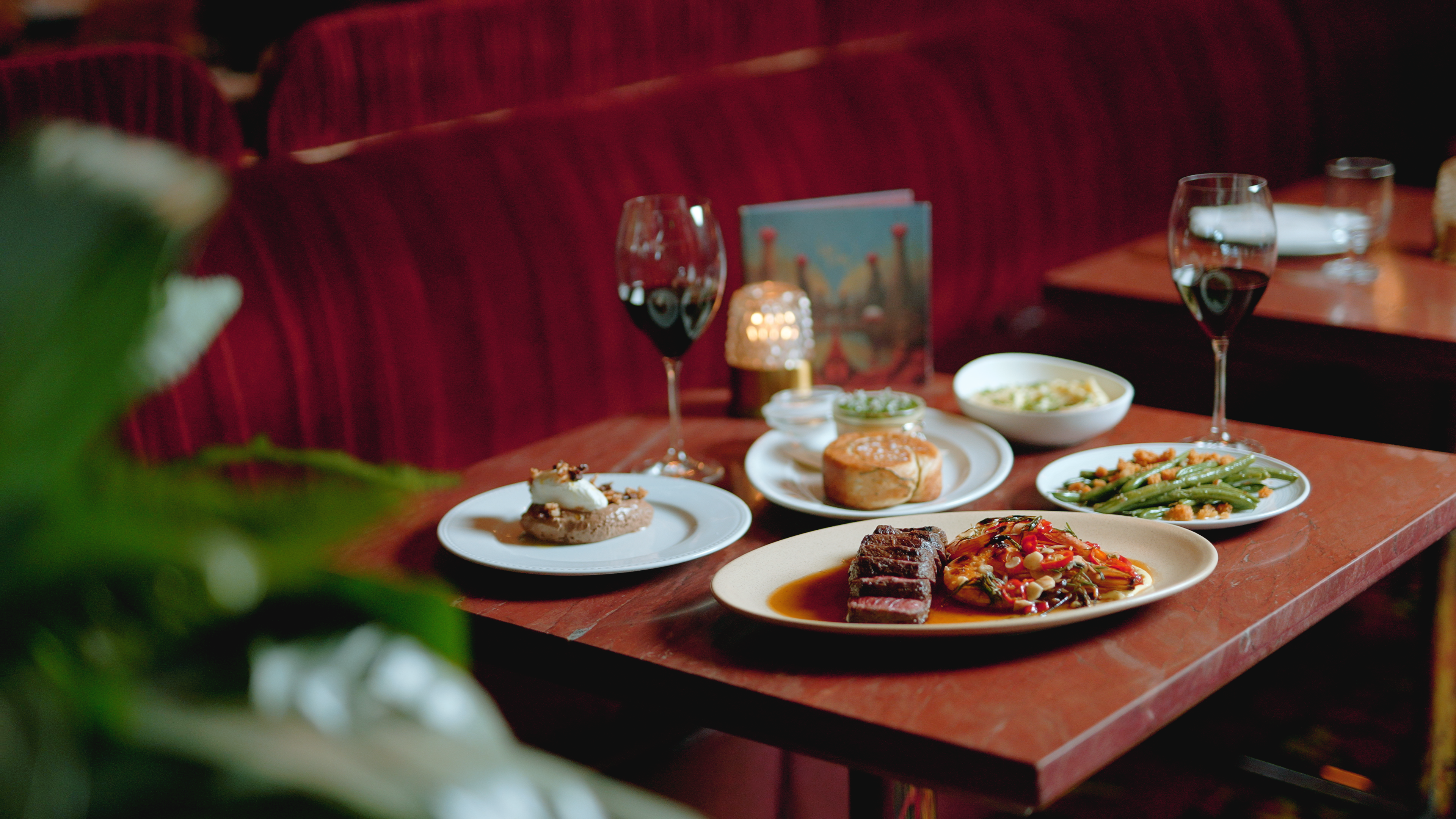It had been open six weeks when it got the Michelin star. At six weeks, a restaurant is a newborn. Newborns wail and struggle to breathe. They’re cracking open their first panic attack. Nine months in the flotation tank of the mom spa, then—blammo—the landlord shuts off the water and fairly traumatically evicts them into a drafty world that has no clue about mood lighting.
It’s old food critic wisdom that restaurants need six months to get running and ready for real analysis. Crew members will have lied on their resumes, narcissists will find themselves bored, the strangely emotional demands of diners will break newbies. It’s a fresh organism dedicated to executing nightly public theater, and it takes time for all the parts to learn how to operate as a fluid whole—develop mutually beneficial roles, nail the timing, speak the unspoken language.
Granted, the team at Lilo in Carlsbad aren’t newcomers, and they’ve had way more time than they ever wanted to plan this out. Plus, the partners—restaurateur John Resnick and chef Eric Bost—helped earn their restaurant across the street, Jeune et Jolie, a Michelin star (and they run its raved-about sister restaurant, Campfire, down the block).
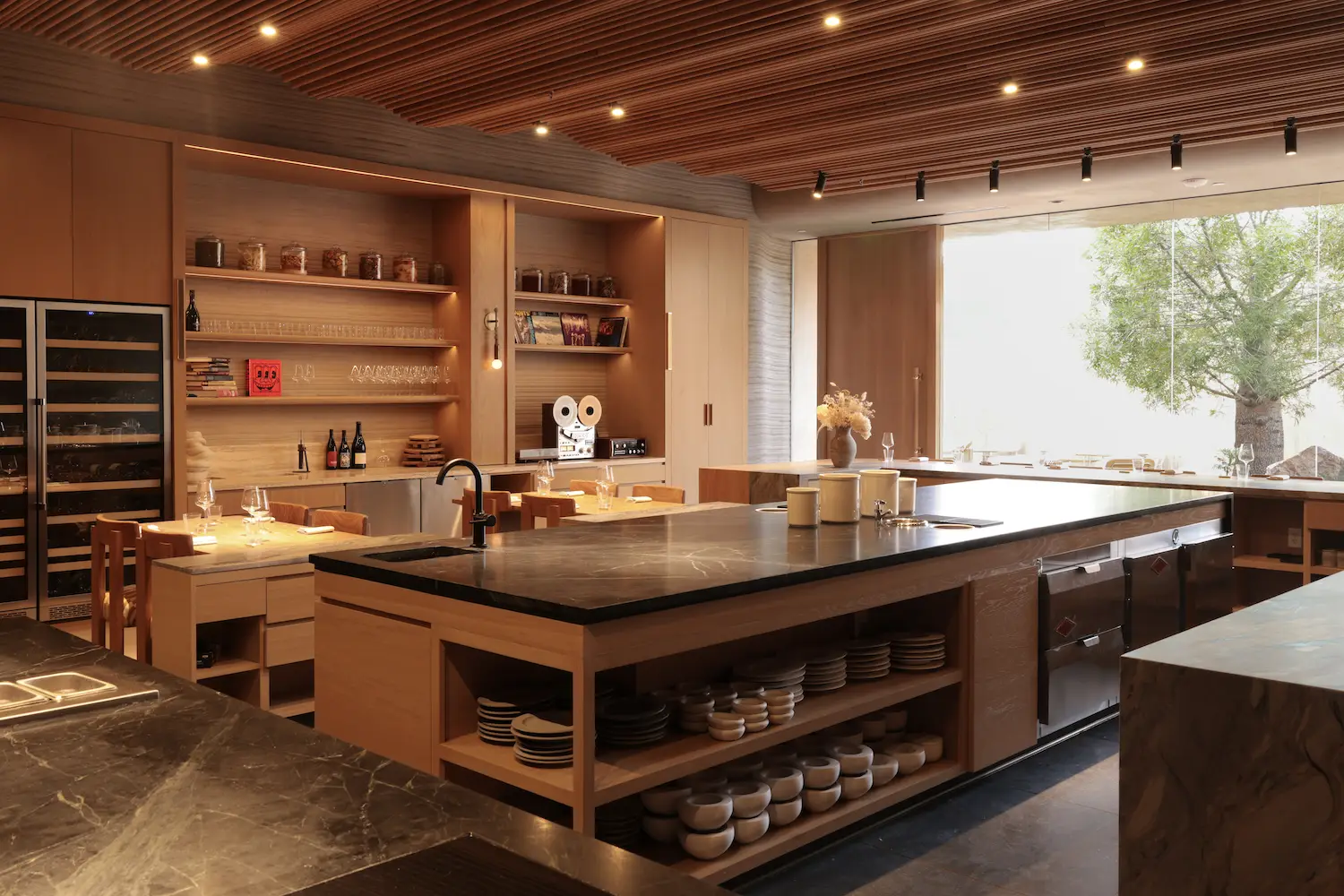
Analog music helps set the mood in here.
“We’re lucky,” Resnick says. “About 80 percent of the people on our team, we either worked with immediately or they came back because they were excited about this project.”
The project is a 22-seat, tasting menu–only restaurant featuring Bost, longtime chef de cuisine Dusan Todic, wine director Savannah Riedler (formerly of Post Ranch Inn and two-Michelin-starred Saison), and beverage director Andrew Cordero (Jeune et Jolie and Campfire). It’s four years in the making. When a 10,000-square-foot building became available on State Street in 2021—the last of its kind on one of Carlsbad’s most up-and-coming drags—they jumped at it. The plan was to build a massive all-day restaurant (Wildland, now open) and, behind it, tiny Lilo, where they could showcase what their vision of the ultimate San Diego dinner experience could be. It’s the kind of James Beard Award and Michelin bait that ambitious restaurateurs dream of and makes basic sense when they have a chef-partner like Bost.
“Campfire and Jeune—from the time leases were signed to opening doors—took about 12 months,” Resnick says. “So I kind of felt like, alright, 18 months should be doable.” He pauses. “It was not.”
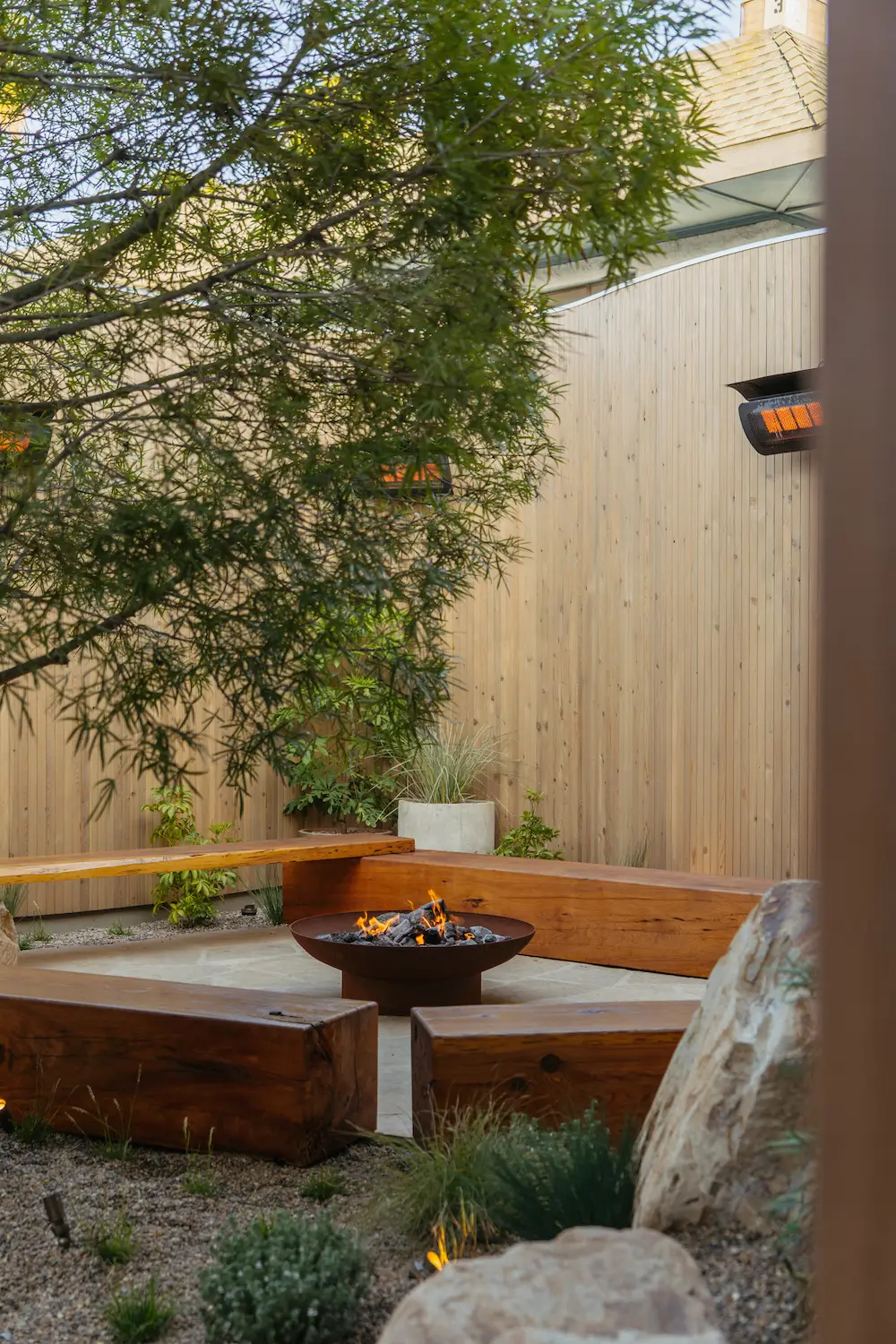
Your meal begins in the serene courtyard.
At that time, the pandemic was still slowly releasing its chokehold. Supply chains had been shot with a billion tranquilizer darts. Building two restaurants at a time while exhibiting a noble American amount of ambition was no picnic. The week after the project finally broke ground, the construction lead on the project—“the only person more essential to the buildout than us as owners,” Resnick says—departed. A fun idiosyncrasy of construction in North County is that most contractors live 40 minutes away and prefer freelance gigs closer to home. So, finding help was hard. Plus, a new ordinance had been passed in Carlsbad since Resnick opened his first two restaurants.
“I was down in Baja having lunch when I got an email about needing a ‘minor site development plan,’” Resnick remembers. “I was like, ‘Well, it’s got the word minor in it; it’s probably not a big deal.’ That one thing added nine months to the project.”
Project costs ballooned. Hems were hawed. The buzz on this project had been loud, and now the scene wondered and whispered. I ask Bost and Resnick if there was a time they considered giving up or drastically reducing the vision.
“It came up, yeah,” Resnick says. “At the end of the day, it was a ‘the only way out is through’ type of thing.”
They thought they’d launch in July 2023. The doors opened in April 2025.
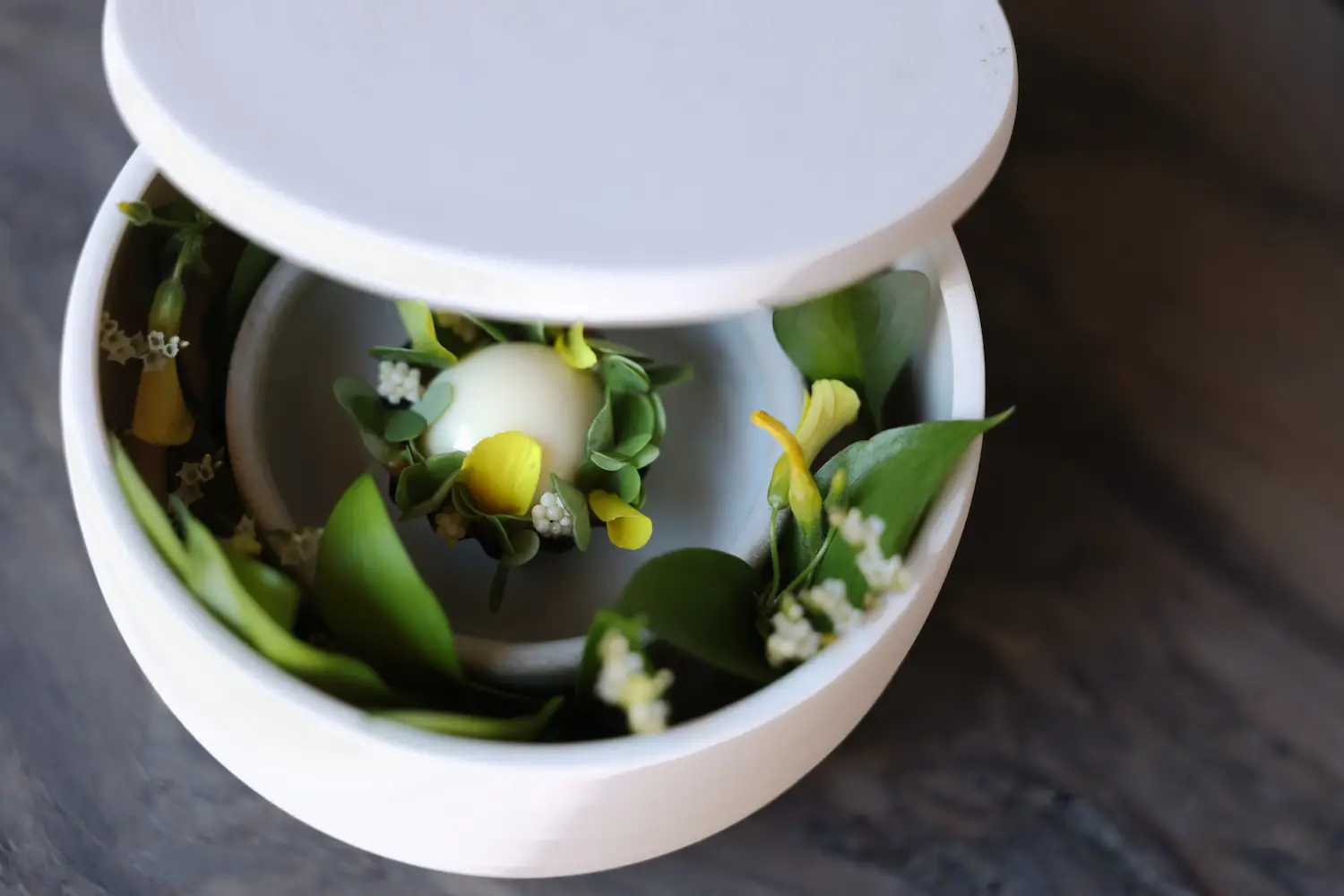
A tartlette made with vin jaune, or “yellow wine,” a dry French white aged for years under a film of yeast.
The Redemption
For Bost, the unveiling of that restaurant was especially redeeming. In 2020, he’d lost what felt like everything. He’d spent 20 years working his way through some of the world’s best kitchens: Le Cirque, The Ritz-Carlton in St. Thomas, Alain Ducasse, and both The Lodge at Torrey Pines and The Inn at Rancho Santa Fe in San Diego. He hit the top when he was named executive chef for Guy Savoy, launching the famed French chef’s elaborate Vegas restaurant and then overseeing his places in Singapore. In 2017, ready to do his own thing, he returned to SoCal and spent two years developing the idea for his dream restaurant. He finally opened his unpretentious tasting-menu place, Auburn, in LA in 2019.
The world’s best chefs came to eat: René Redzepi of Noma, Grant Achatz of Alinea, Savoy. It was widely, widely loved. Then, on the day of Auburn’s one-year anniversary, all LA dining rooms were ordered to shutter due to Covid. They tried takeout and all the things, but money ran out and it didn’t work. That chapter, the one he’d written in sweat and blood and life savings, was closed. He’d reached the top, and now he needed a job.
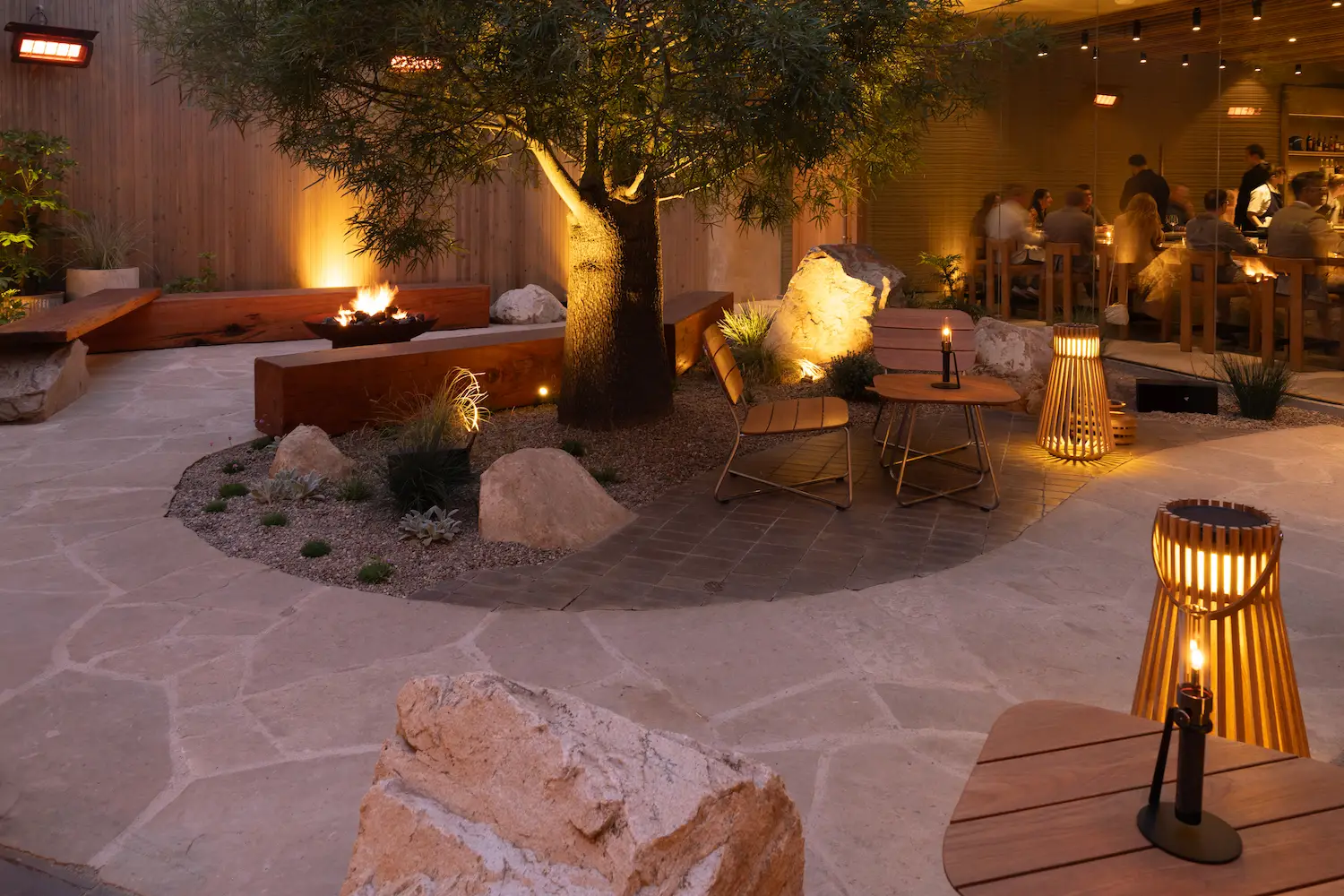
After a courtyard amuse-bouche, you take a seat at the chef’s counter for 16 or so more courses.
“I had worked so hard for so long, and it felt like my whole world collapsed,” Bost says.
Down here in San Diego, Resnick had lost a rudder, too. His longtime partner—chef Andrew Bachelier, who opened and ran Campfire and Jeune et Jolie—left to be with his family during the pandemic. So Resnick reached out to Bost and brought him back to San Diego. A few months after his return, I took my family to Jeune et Jolie. I’d never tried Bost’s food, and it was a revelation. I wrote a nearly unhinged rave for SDM.
Jeune was awarded its Michelin star a few months later and has retained it for four years. Lilo is the duo’s second star, and it seems destined for at least one more.
“Five years after I lost Auburn, we’ve reached a success that, at the time, seemed impossible,” Bost says.
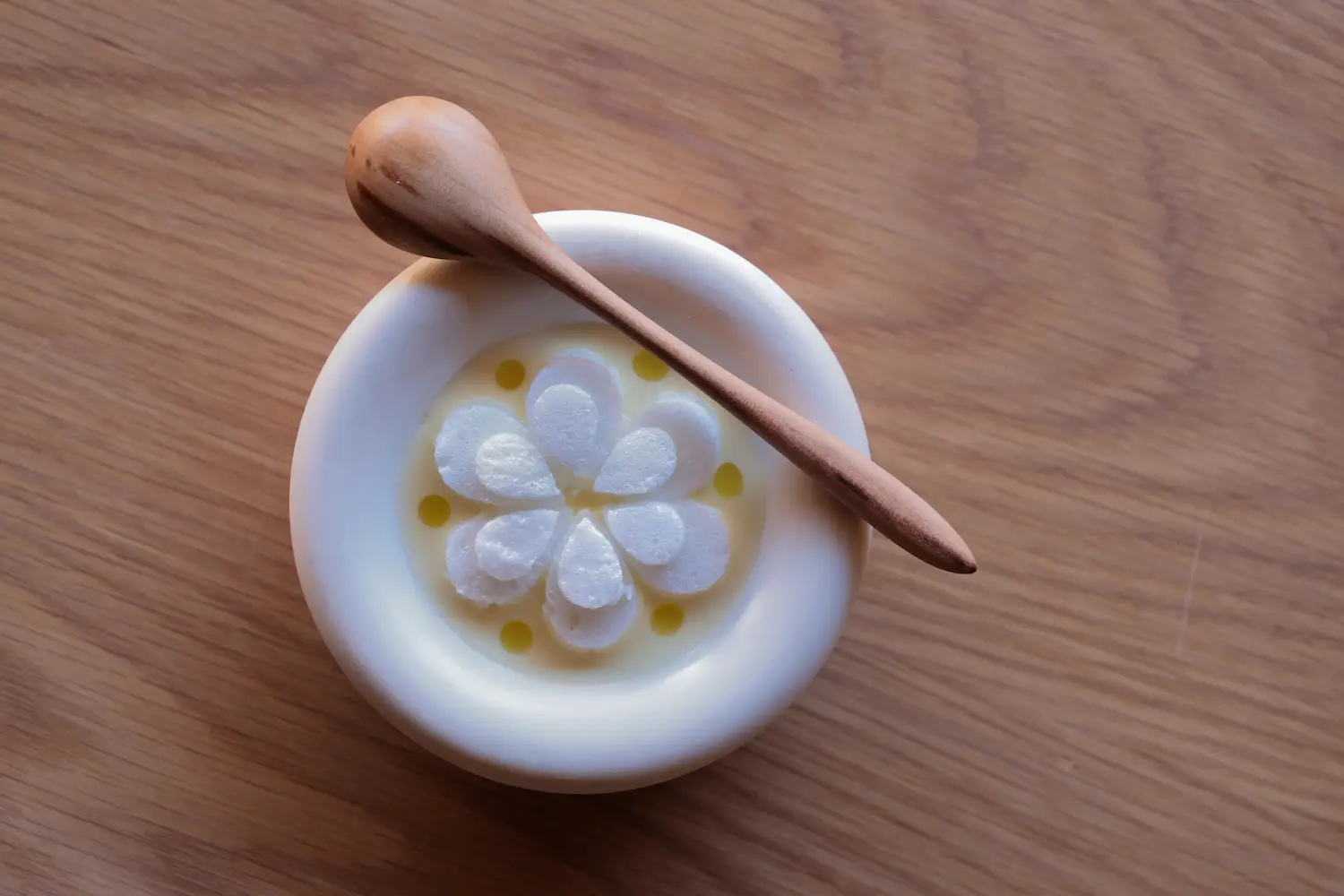
Lilo’s delicate île flottante (“floating island”), meringue suspended in a pool of crème anglaise.
The Arrival
A college textbook on architecture that perfectly explained my childhood also explains the physical experience of Lilo. As a pre-internet teen in suburban North County, if I wanted social interaction outside of school, I went to the indoor mall then known as North County Fair. The odyssey started in some remote hinterland of the parking lot (malls were jammed in the ’80s). You’d traverse the sweltering asphalt acreage in the irrational Escondido sun, broiled from underfoot. The exterior of North County Fair was no eye candy, just beige stucco with fancy retail logos. You’d finally arrive, hot and sweaty and uninspired, and open the doors to the mall… and a wave of air conditioning and lights and joy and music would save you. You never wanted to leave, and your estimation of this mall had some messianic-capitalistic undertones. Turns out this is an actual form of architectural strategy and psychology.
Lilo is the same. (Okay, not exactly.) It’s in Carlsbad, for chrissakes, where even concrete is somehow charming. But the emotional experience of entering feels shockingly transportive. It’s tucked in a parking lot behind its sister restaurant, Wildland. Your journey includes pilgrimaging across the 50 feet of asphalt under temperate, marine air toward a tall, soft, slatted wall of curved wood that looks like it’s got a skincare routine, embossed with small black letters that say “Lilo” in a retro sans-serif font (in the constantly fonted psyche of modern humanity, a nice font is the underrated eye Prozac). You turn the corner into the courtyard and… salvation. Pleasure vertigo. A billowy tree billows. A handful of tables speckle the courtyard, which feels like it should have an earthen sauna with steamy rocks and Wim Hof sipping shrubs in an ice bath. You could stay here forever.
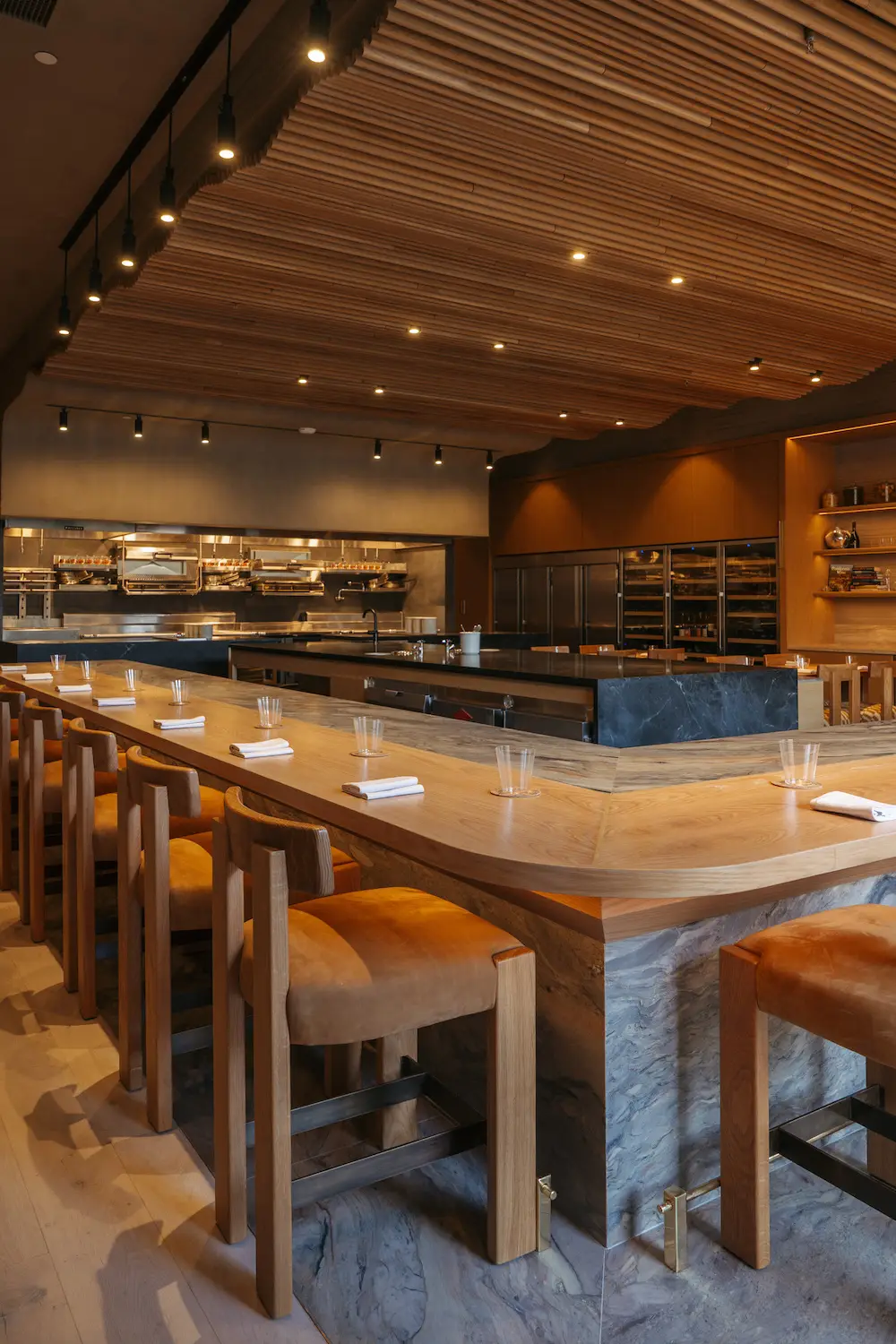
Each of the restaurant’s 22 seats offers front-row views of the whole choreographed show.
This is where the meal starts, with a trio of amuse-bouches and a welcome cocktail or zero-proof creation. It’s the naturalist decompression chamber. Then you enter the single dining room through a massive wall of glass, Mos Def or Lou Reed or Nina Simone playing on the reel-to-reel. “Dining room” is the wrong phrase. It’s essentially just 22 barstools at a U-shaped counter that surrounds the chefs and drinks people. They’ve trapped themselves into this experience.
You’ll be fed approximately 16 courses over the next couple hours. And you start to see the theater evolve. The crew is trained and guided on 73 sequences of service, under which are about 350 subnotes and thoughts on how to enhance the guest experience and handle the unexpected free radicals of placing 22 humans in a glass box. There are notes on how to open the door, where to stand when it is open, how far apart the seats should be (19 inches), how to pull out the chair (not a small feat; it’s all heavy, one-of-a-kind barstools). Ironically, the goal of these obsessive guidelines is to undo the roboticism of the formal restaurant experience.
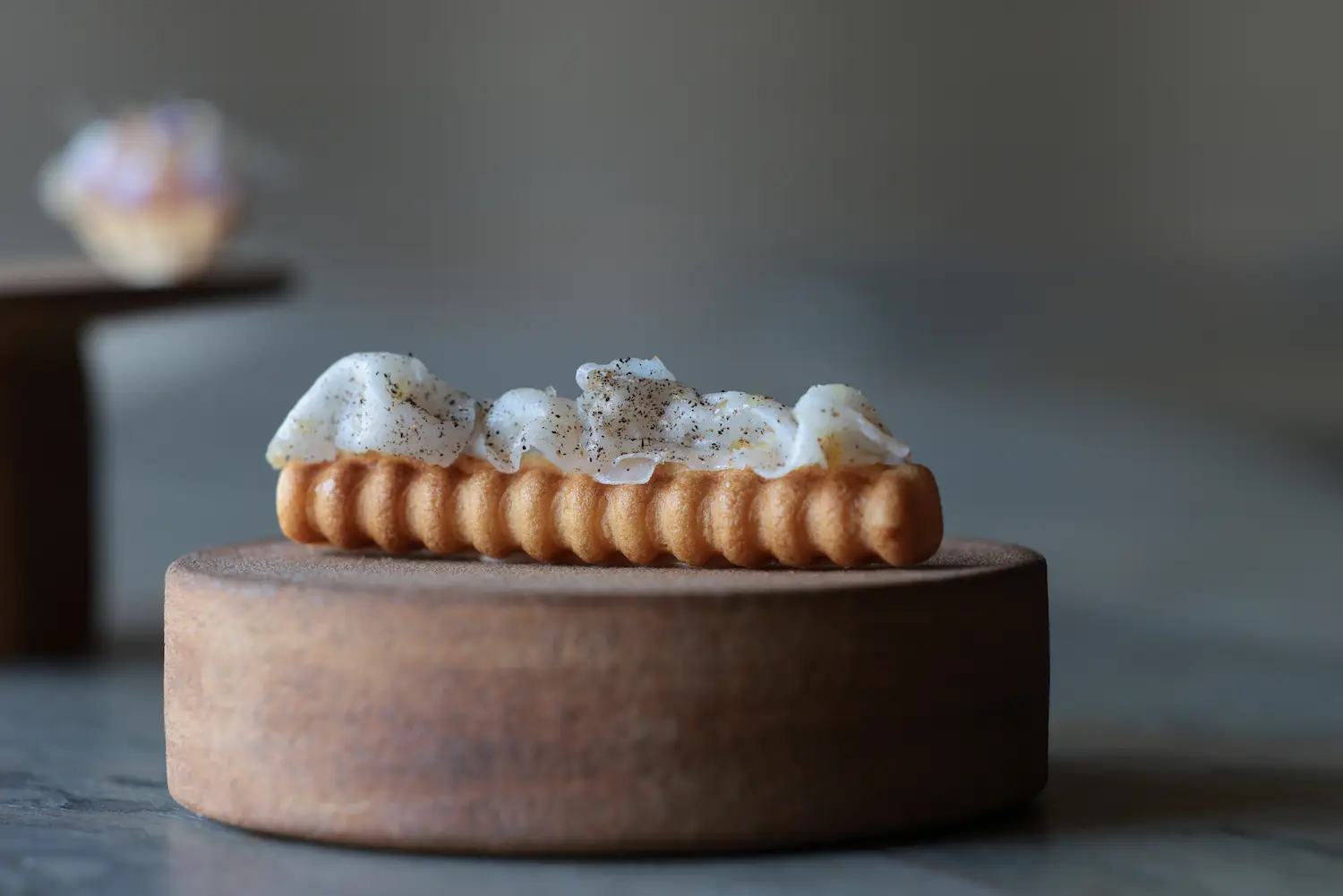
Gougères—savory pastries made by mixing choux dough and cheese—get waffled at Lilo.
“The whole point is for our team to not have to think about it,” Resnick says. “Things will fail during service, and if you have to think about how to handle it, you’re not going to be able to be in the moment and connect with our guests and just have fun. You don’t want a guest to notice that all the chairs are lined up and spaced out exactly 19 inches apart from each other. But they are. The whole point is, ‘How do we make this feel super effortless and lovely for the guest?’
“I’m the kind of person that, when I leave a restaurant, no matter how exceptional it was, a couple weeks or years later, I really don’t remember what I ate—but I remember how I felt. I was really excited about doing something that made you feel like you were having a special evening but you could be yourself. You wouldn’t have to be on your best behavior or feel like you had to be contrived to fit into what we were doing. We want it to feel communal, like we’re all doing this together—a chef’s counter can do that a little bit, I think.
“Just have fun. There’s good music playing. You can come in and laugh and have this rad night, and it’s also one of the best meals of your life. That’s the hope, at least.”
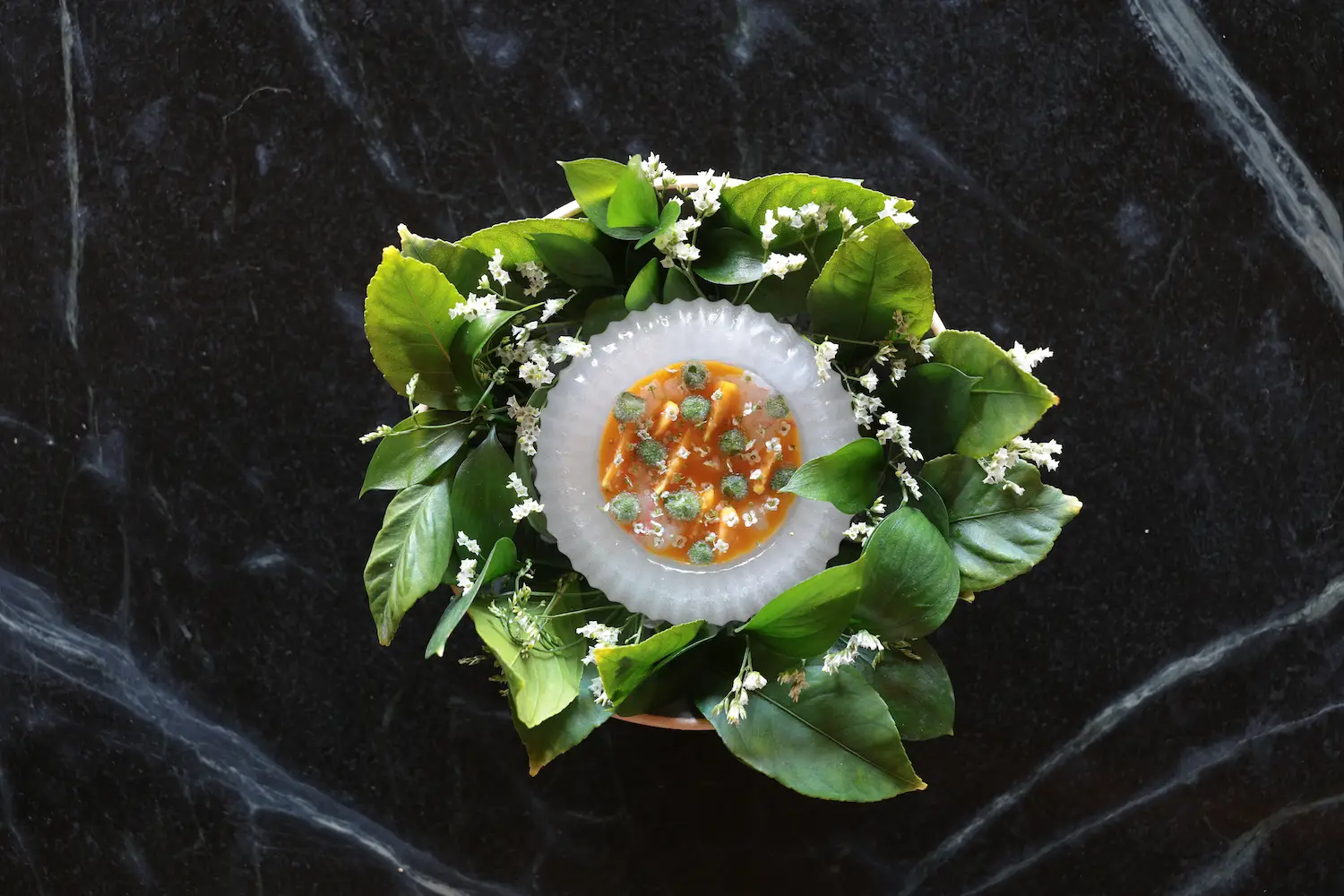
Spot prawns, a California delicacy, come to the restaurant straight from the boat.
The Feel
So, how does it feel?
You get the sense that, if your chi was dirty here, the staff would figure out how to wash it in botanical water hauled from a natural spring noted for its good omens, then clarify that omen water in a centrifuge and mix it with a cocktail shrub that’s been calibrated to the type of chi you possess.
There’s a dish that Bost and Todic created at Jeune et Jolie as part of the dreaming and R&D’ing for Lilo. It is one of the best things you’ll ever eat—ultra-local Californian and lightly Asian (both central tenets of how they cook); unexpected; bordering on weird; both a challenge to what we expect of food and an embrace of its base, comforting flavors.
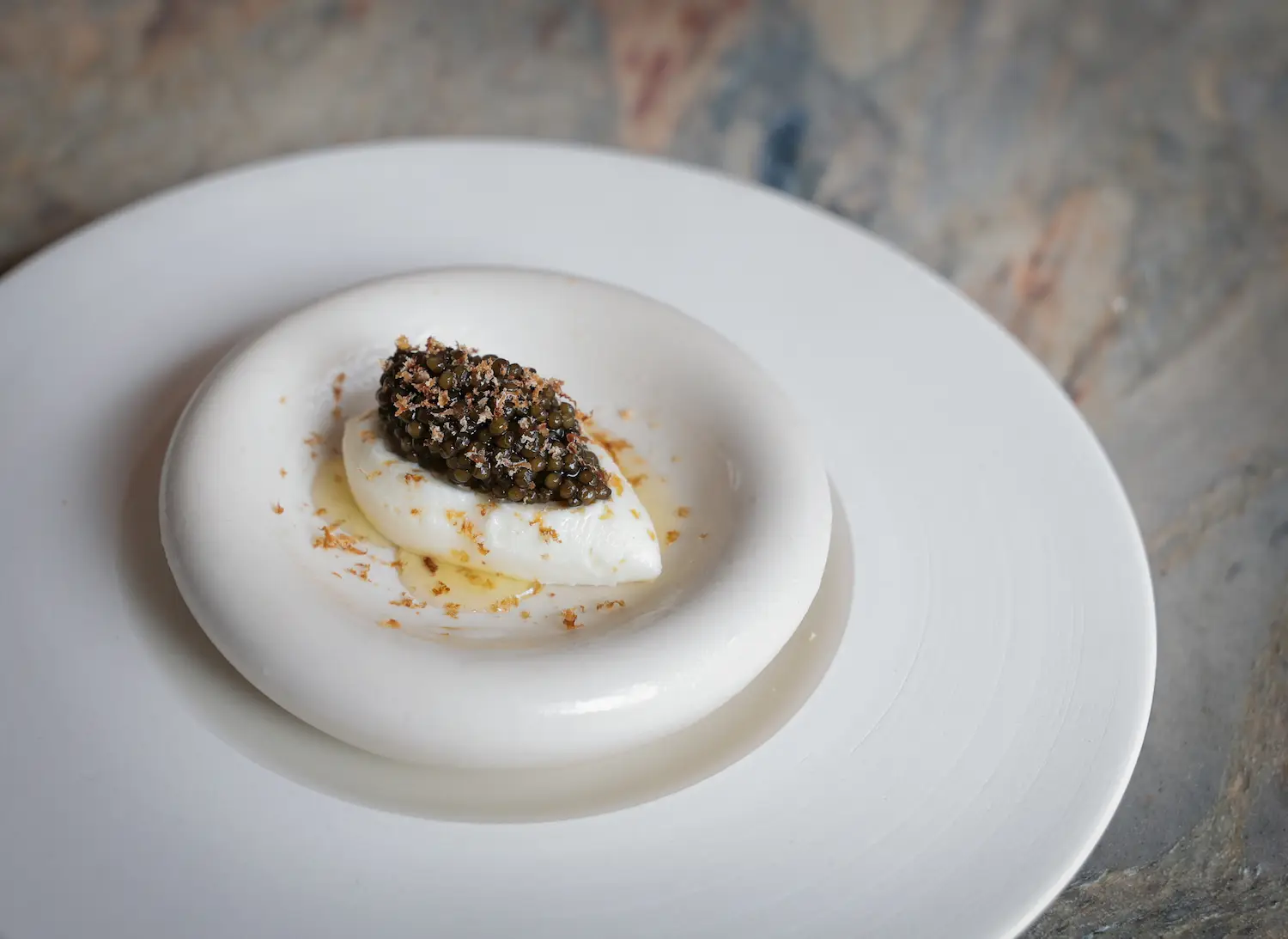
Orgeat ice cream, crowned in caviar.
It’s the orgeat ice cream with ossetra caviar. Orgeat is a cocktail ingredient that tastes like candied almonds and orange blossoms. The key to the dish is a celery root bushi, made from curing celery root in a mixture of brown sugar, tamari, and salt for two days. Then the root is smoked over almond wood for another two days. The chefs spend another couple days completely drying the root. They finally shave it over the top of the dish with a drizzle of freshly pressed almond oil (they make it daily in-house). It takes the standard idea of fine dining— caviar and crème fraîche—and puts a little Michelin-starred Ben & Jerry’s into it.
“That dish was from way back in the process, when we thought we were going to open earlier,” Bost says. “We had orgeat ice cream on the menu at Jeune for a time. I was just ruminating about what the food at Lilo would be. I knew we were going to have a caviar course at Lilo, and for some reason, I just made the connection with the ice cream. I grabbed one of these big Japanese ice cubes we had at the bar, dropped the quenelle of ice cream on that, put caviar on top, and took a bite. It was jammy, sweet, salty, fun. And I’m like, ‘Dusan, this is what I think the food should be, you know? It’s thoughtful and incredibly delicious, a little playful. Now how do we do things like this through 17 courses?’”
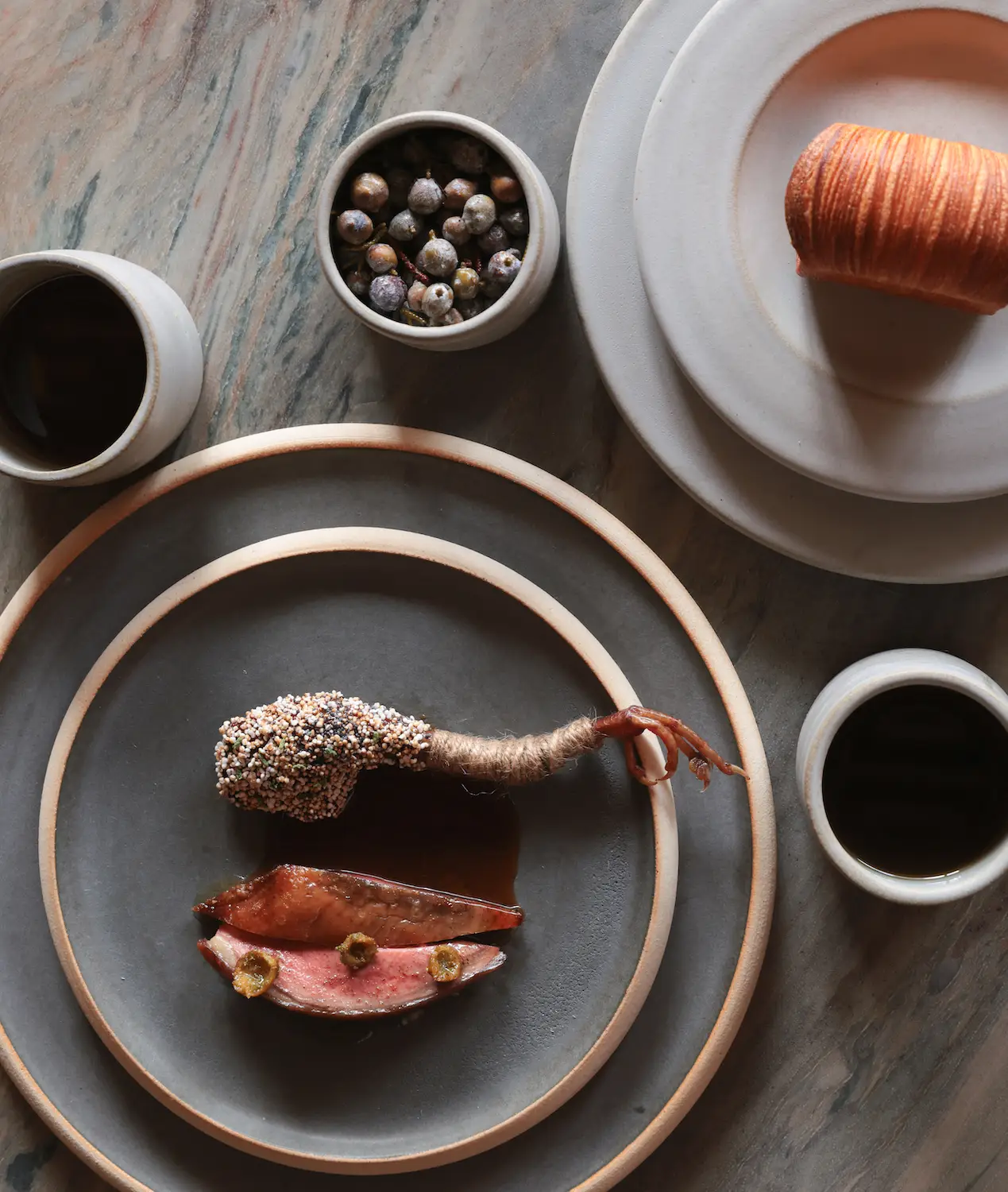
Roasted California squab (a young pigeon).
Bost’s and Dusan’s menu—hyper-local, hyper-seasonal, leaning Californian and Japanese (plenty of koji and fermenting)—evolves constantly based on farmers’ and fishers’ hauls, and whim. For instance, the most recent includes big-eye tuna and Wagyu tartare with yuzu, black radish, ginger, and spruce; gougères filled with comté Mornay, barrel-aged maple syrup, and Iberico lardo; abalone brushed with fermented pepper and guanciale in a broth of chicken and bone marrow; blackened banana with Koshihikari rice, medjool date, shiro miso caramel, and a roasted rice donut.
Each person on staff has an eleven-and-a-half hour shift—first, a meeting to go over every guest and special occasion or need, then a shift meal where work is not discussed, then the show and the post-show wrap. Every dish is assembled at guests’ eye-level, a few feet away, not unlike sushi omakases, except with way more moving parts to the dishes. A different cook or chef or beverage person delivers each dish as it is ready, which means everyone is responsible for the story.
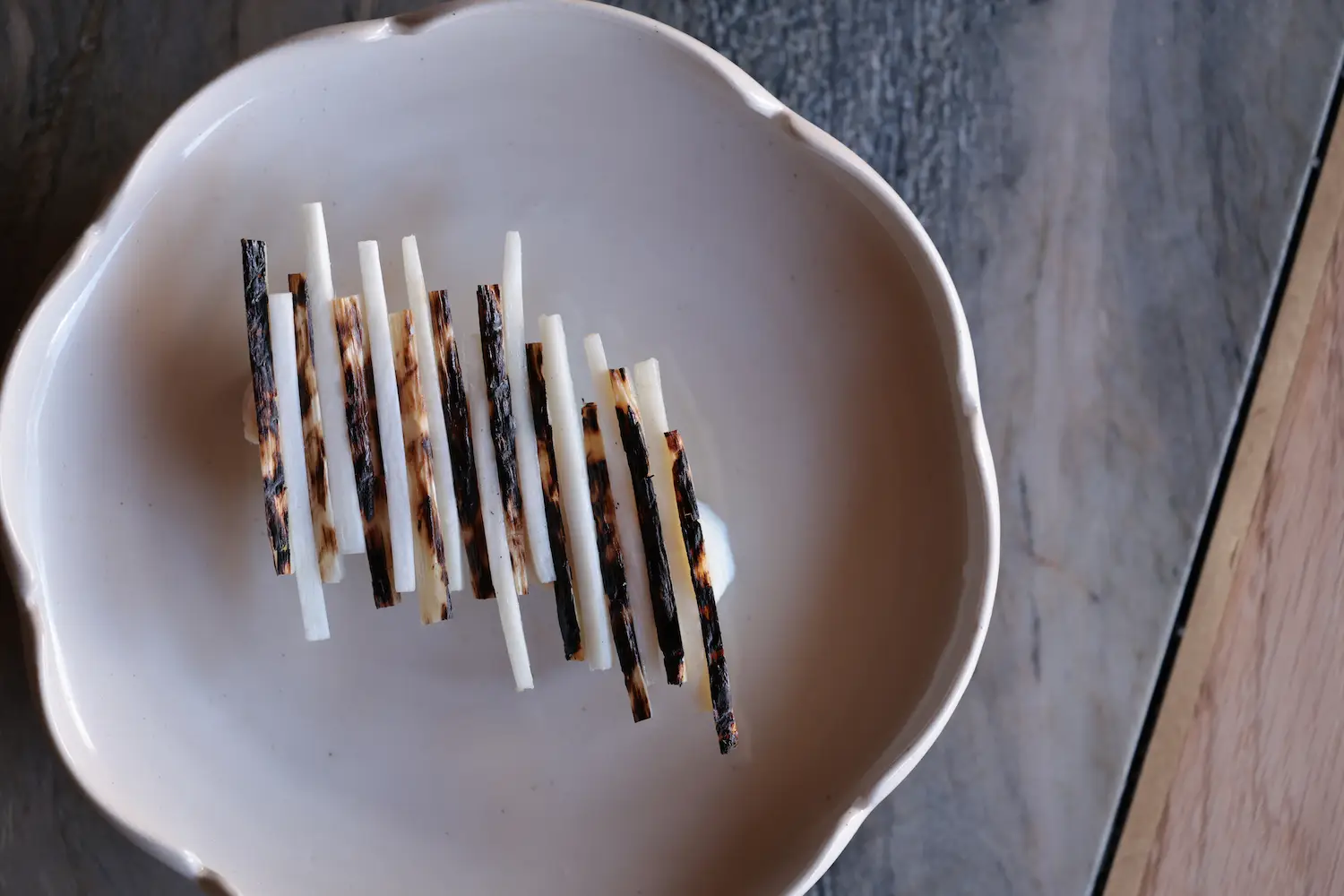
Delicate white fish becomes a Daniel Buren painting.
“That actually takes a special kind of chef and kitchen staff, because not every chef got into this to be guest-facing,” Bost says.
I went opening night, part of a crowd of friends and family asked to give as much useful criticism as possible and help Bost and Resnick and their team see it from outside eyes. Day one—the first rough draft—wasn’t perfect, but damn if it wasn’t close to it. One of the best meals you’ll find in San Diego.
PARTNER CONTENT
It works because of Bost and Resnick and their staff’s decades of thankless experience. It works because Bost is one of the most talented chefs in the city. But it feels somehow casual because of all the detail-gargling and obsession ahead of time—and then, doors open, cue the Jurassic 5, and just be.
“In the beginning, we thought about maybe bringing in a dancer to help with training,” says Resnick. “We didn’t, but there are so many things when you’re in this intimate of a space—when you need to bend down to open a drawer as guests are sitting right there staring at you. It’s all those little things, and sometimes we talked for hours about them.”
